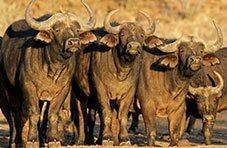Cape buffalo is a member of the Big Five family, a name given by hunters 100 years ago to describe the five most difficult and dangerous animals to hunt on foot. While the term stuck to this day, it’s now primarily used in touristic marketing for wildlife safaris which give one a chance to observe these magnificent animals in flesh. On top of the African buffalo, the group also includes African lion, African elephant, African leopard and rhinoceros. Each has its own special traits, and in the text bellow we’ll explore those of the intimidating Cape buffalo.
Strong As a Bull
Cape buffalo is the largest of Africa’s wild bovids and strong enough to tip a motorcar. it has a long and stocky body, short thickset legs and can weigh up to 1 ton. Male buffalos have characteristic horns fused at the base, forming a bone shield called “boss”. These will be used when sparring, either in play, when asserting dominance or fighting for real. Buffalo can be a mean and aggressive creature, which in combination with its strength, results in violent but brief fights. It will fight for rank and female, and charge few of the predators which dare to attack. While aggressive towards humans and other animals, these herbivores are very protective of each other. They will take care of sick and old members of the herd and protect them from predators. Average lifespan of the Cape buffalo in the wild is 20 to 25 years.
Looking for Grass, Water and Shade
Cape buffalos will inhabit all types of grassland in sub-Saharan Africa, be it dry savannas, swamps and floodplains, forest or glades. The most important thing when choosing their habitat is distance to water source as they require water daily. Finding shelter from heat and danger is also an important influencing factor. Quantity of available food is more relevant than its quality, due to the fact buffalo needs to eat a lot of grass to sustain its bulk. Its wide muzzle and a row of incisor teeth make it possible to take big bites and they’ll use their tongue when feeding, just like other bovids.
Buffalos are also good swimmers and can cross deep waters in search of better grazing. However, unlike water buffalos, they prefer to keep cool by lying under the trees than spend their days in water. At night, they enjoy the cool air while grazing.
Family Life
Cape buffalos are social animals which move around in herds, and while the herd size is highly variable, it can count as many as 1,000 members. Herds are normally of mixed gender, with clans of related females and their offspring and usually one dominant male. Bulls have a dominance hierarchy based on age and size, determining which bulls breed. During the dry season, males will leave the herd to form bachelor groups, while during the rainy season younger ones will rejoin in order to mate with the females. After a gestation period of 9 to 11 months, calves are born and remain hidden in vegetation for the first few weeks, before their mother takes them to the main herd. The bond between mother and its calf lasts longer than with most bovids but, when a new calf is born, bonding ends.
When chased by predators, the herd will stick close together with calves gathered in the middle. If a member gets caught, buffalo will try to rescue it. They are also known to retaliate and kill the lion which has previously killed a member of the group. Lions are this herbivore’s biggest enemy, apart from humans. When attacked, buffalo will put up a good fight and it will usually take several lions to bring down a single adult male.
Vocal Democrats
African buffaloes communicate by body movements and vocalisations, exhibiting a limited repertoire of sounds. They will produce short low-pitched calls to signal the herd to move, and gritty, creaking sounds to make it change directions. Long explosive grunts are a signal of aggression. Mothers make a gargling-like call to their calves when faced with danger. If it feels threatened, buffalo will show you its side, to demonstrate how large he is and give you the chance for a speedy retreat. It will also rub its horns on the ground to threaten the opponent.
Cape buffalos appear to be democratic, engaging in a sort of a voting behaviour. To make a decision on the direction of their travel, they will stand and turn towards where they want to go. Majority of votes wins! While elephants never forget, buffalos never forgive. They’ve been known to attack people which have harmed them years ago, which clearly also necessitates a good memory.
Humans, Beware
With a global population estimated at about 900,000, buffalo is listed as “least concern” by The International Union for Conservation of Nature. As he belongs to the big-five game family, Cape buffalo is a sought-after trophy. However, its mean and unpredictable nature makes it highly dangerous to humans. In fact, Cape buffalo is also known as "the Black Death" and "widow maker", reportedly killing more than 200 people every year. So, while you might enjoy the sight of this intimidating herbivore when on a safari, you might want to keep your distance. Especially if you see one showing you his “good side” or rubbing his horns on the ground. It will be a sure sign it’s time to pack up and go. Fast.




